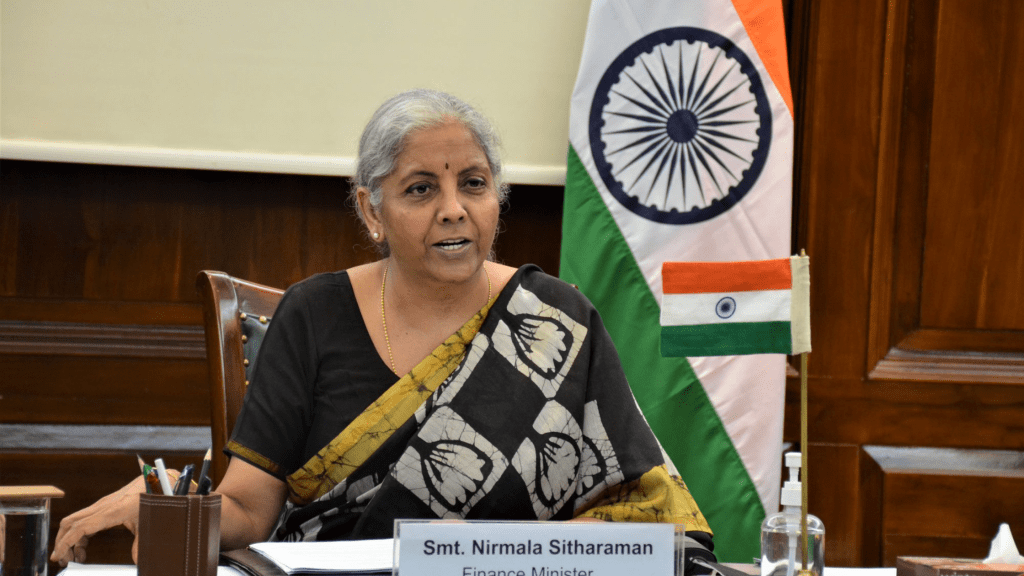Key Takeaways:
- Indian Finance Minister has expressed concerns over the use of crypto in illicit activities
- According to Sitharaman, cryptos can be used for money laundering and terror financing activities
- The use of fiat currency and gold by cyber criminals is higher than cryptocurrencies

YEREVAN (CoinChapter.com) – Indian Finance Minister Nirmala Sitharaman has amplified her attack on cryptocurrencies. During a panel discussion titled “Money at a Crossroad” hosted by the International Monetary Fund (IMF), Sitharaman said people can use crypto for money laundering. In addition, she expressed concerns that global terror groups will also use digital assets to fund their activities.
Moreover, the minister reiterated the fact that the Indian Government does not recognize cryptos as a currency. Leaning on traditional definitions, she defined currency as “that which is backed by the Central Bank or by the Government of a Country.”
However, acknowledging the importance of the technology driving cryptos, she claimed her ministry is not against technological advancement in the sector. According to her, cross-border payments between countries will become very effective through Central Bank-driven digital currencies instead. She had earlier announced that the Reserve Bank of India (RBI) will roll out its digital currency soon.
“I think the biggest risk of all countries accross the board will be on the money laundering aspect, and also on the aspect of currency being used for financing terror,”
she said.
Nirmala Sitharaman supports taxation despite the gray status
According to the finance minister, there is no contradiction between not legitimizing cryptocurrencies and imposing taxes on gains from them.
For the uninitiated, Sitharaman had announced a massive 30% tax on all gains from crypto transactions earlier this year. The move had earned widespread criticism owing to the fact that India is yet to define crypto and decide upon its status, yet the government wants to take a huge bite of traders’ profits.
However, according to the Indian Finance Minister, taxing crypto helps determine the source of transactions to keep a trail of them. This will, in return, help the Government take measures to prevent money laundering and terror financing. Taxation, in her view, does not necessarily mean legitimizing cryptocurrencies.
Needless to say, this logic does not help justify the high tax rate as the same trail can be followed through a much lower taxation scheme. Sitharaman also argued that regulation via technology was the only answer to deal with cryptocurrencies.
“Regulation using technology will have to be so adept, that it has to be not behind the curve, but be sure that it is on the top of it,”
she added.
By invoking illegal practices such as terrorism and money laundering, she is trying to justify her ministry’s unfriendly approach to cryptos. While her concern may seem genuine, and in some cases really is, global statistics tell a different story.
Recommended: Indian MP Sushil Modi fears cryptocurrencies because he does not understand them
Share of llicit activities in cryptocurrency transactions low
According to data published by Chain analysis, the share of dubious activities from the total crypto transactions is almost negligible. The growing adoption of cryptocurrencies has brought cybercriminals to the field as well.
According to the data, illicit addresses received $14 billion in 2021. That number was $7.8 billion a year earlier. Although this speaks of a 79% increase, the bigger picture tells a different story.

The total transaction volume reached $15.8 trillion in 2021, a whopping 567% increase from 2020’s totals. Given the massive crypto adoption, the $14 billion, while unfortunate, is not a staggering number. In fact, illicit addresses were involved in just 0.15% of cryptocurrency transactions. This is a massive drop from the 3.37% in 2019.
Recommended: Indian MP wins hearts after lashing out at Modi government for unfriendly crypto policy
Fiat more common in money laundering than crypto
While the Indian finance minister takes every opportunity she gets to swing at crypto, she ignores one important fact. More than giving cybercriminals the opportunity to launder money, blockchain technology, and cryptocurrencies empower governments to fight crimes.
Unlike gold and fiat currencies, crypto transactions leave permanent trails that help in nabbing criminals. According to Janek Tarnatunga, CEO of Australia’s Institute of Certified Management Accountants (ICMA), private banks facilitate more illicit activities than cryptocurrencies.
“Contrary to popular opinion, it is quite easy to link Bitcoin transactions together in order to identify a user… Public blockchains are totally transparent and browsable by anyone, while private banking transactions remain hidden from plain sight,”
he writes in a lengthy report.
A case in point is the arrest of Ilya Lichtenstein and Heather Morgan by the US Department of Justice. In 2016, the couple successfully stole 119,754 Bitcoins (BTC) from the cryptocurrency exchange Bitfinex. However, despite going unnoticed, the trails they left behind while laundering the stolen BTC (today worth over $5 billion) led the authorities to them.
Last month, the US Treasury Department released three-yearly reports on money laundering and terror financing. Titled the “National Money Laundering Risk Assessment” report, the document clearly stated that fiat currency has a wider criminal use than cryptos.
“The use of virtual assets for money laundering remains far below that of fiat currency and more traditional methods,”
the US treasury states.
Analysis firm Messari also shares similar sentiments. According to the company, the ratio between fiat and crypto in money laundering is 800:1. For every $1 dollar spent in BTC on the darknet, criminals launder $800 in fiat.
Recommended: Indian and US politicians up in arms against cryptocurrencies
Gold provides more cover to money launderers than crypto
A report by the Financial Action Task Force (FATF) on money laundering and terror financing clarified how gold is a medium of exchange in criminal transactions. According to the FATF, criminals can trade gold anonymously as its transactions are difficult to trace.
“The gold sector includes depository and certificate products which provide legal title to gold bullion which is stored on behalf of the owner. These certificates provide another mechanism for criminals to launder money whilst distancing themselves from the asset,”
the report reads.
Financial Times columnist John Dizard has also argued that criminals increasingly use Gold to launder money.
Recommended: Trade volumes on Indian exchanges fall as new crypto tax law comes into force
India’s FM hurting the country’s economy
India’s hostile policy towards cryptocurrencies stands to hurt the Indian economy. For example, it will result in funds exiting the country as many traders will withdraw their cryptocurrencies to foreign countries. They can do this either directly or indirectly to avoid the high taxes. Moreover, it will result in a huge brain drain from India as many freelancers, digital nomads, and experts working in the field will leave India for countries with friendlier policies.
As a result of the new taxation policy, trade volumes on Indian exchanges have already seen a drop in trading volumes.
According to reports, even Indian crypto exchanges are leaving the country. WazirX co-founders Nischal Shetty & Siddharth Menon have already left India to continue operations in Dubai.
While it is clear that the Indian FM cannot stop cryptocurrencies, what Nirmala Sitharaman is doing is illogical. Regulatory uncertainties and unfriendly taxation policies are costing India dearly. Unfortunately, more people will leave the country, depriving India of the leadership role it can play in space.
According to Nirmala Sitharaman herself, the adoption of technology in India is 86% compared to the global 64%. With such impressive statistics, hampering the country’s growth in the crypto sector is illogical. If the Government wants to fight money laundering and terror financing, crypto is hardly the place to start.


